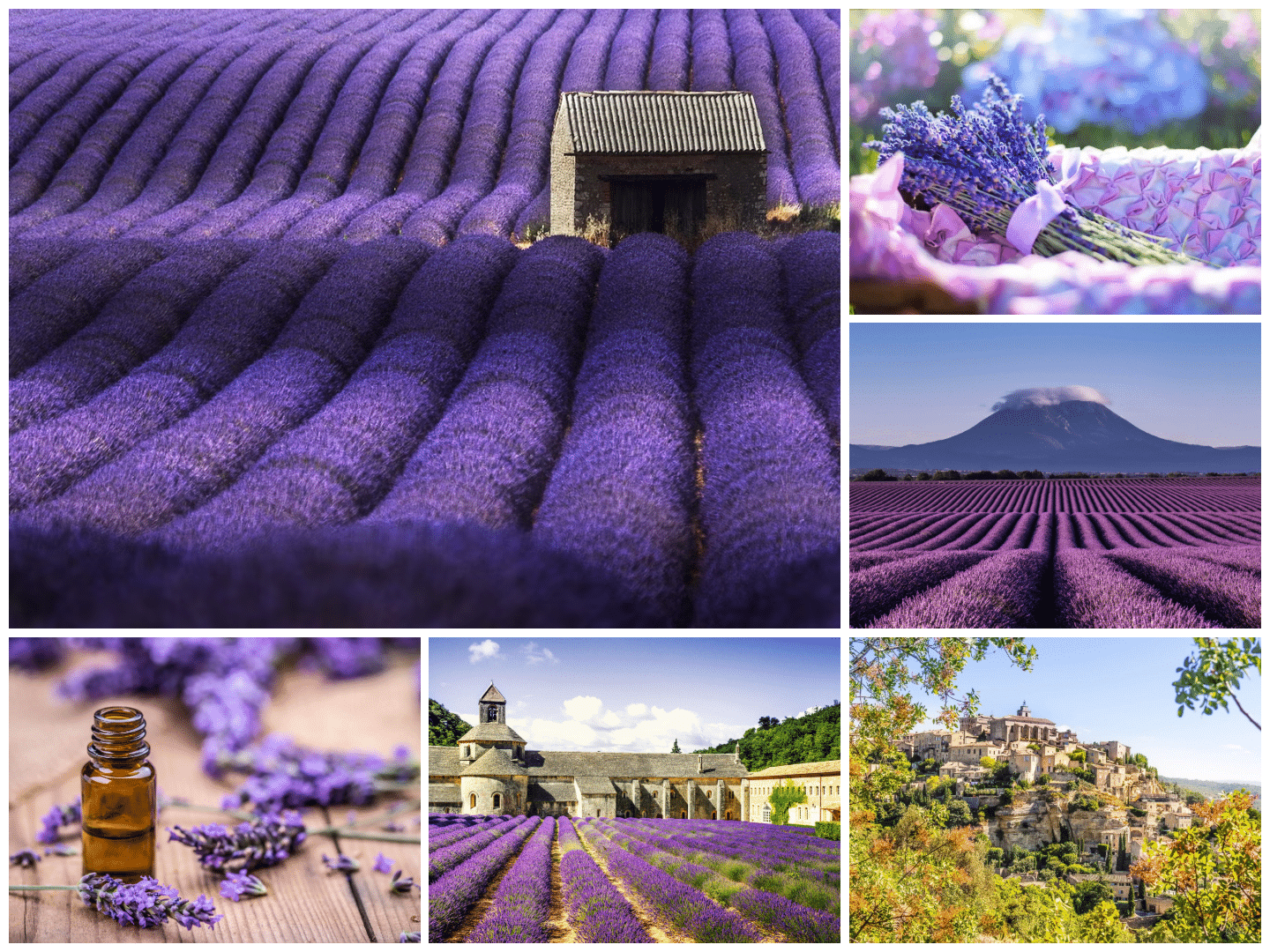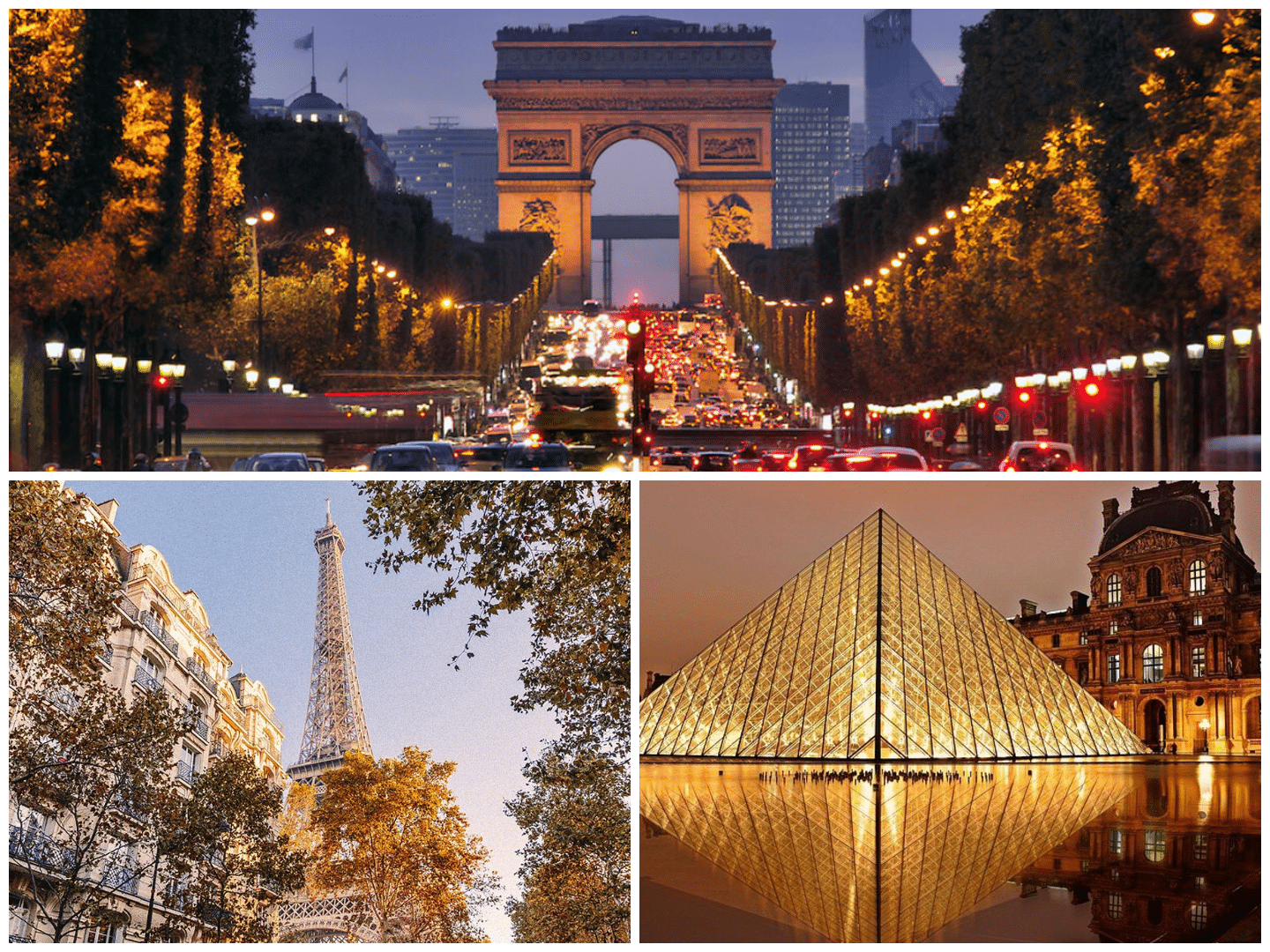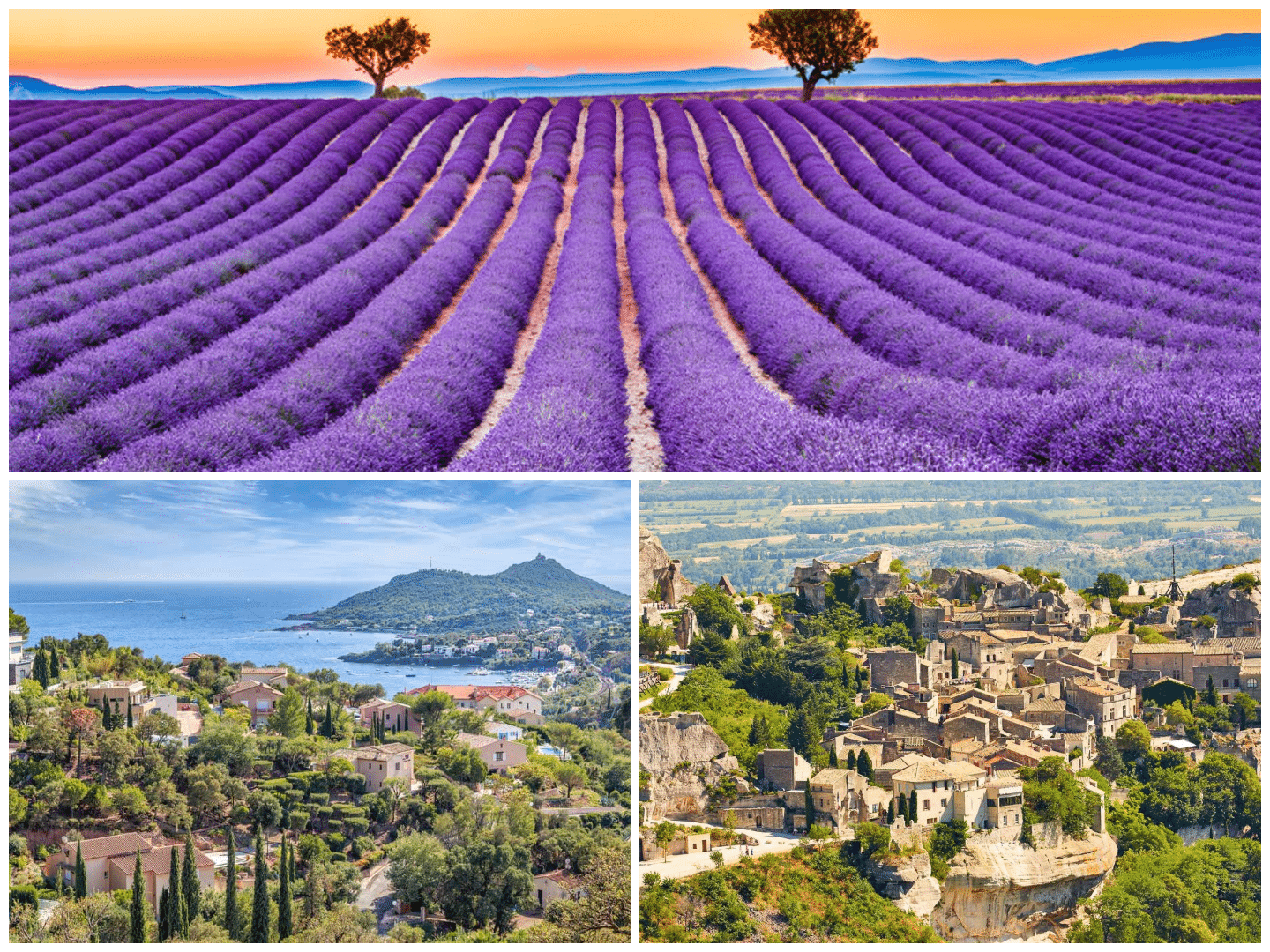This Provence lavender guide will provide you with information about this famous plant, its uses, and its history. Furthermore, we will show you when to visit, where to see the best Lavender fields, and how to get there and get around. Plus, a few top tips. So, if you want to know more, please stay with us.

Our website includes affiliate links. So, remember that we may receive commissions when you click our links and make purchases. Please read our legal disclaimer document for more information about our Affiliate disclaimer and other disclaimers like the Fair-Use disclaimer.
Essential Lavender
The lavender industry in Provence is not just a vibrant force but a unique one, significantly shaping agriculture, tourism, manufacturing, and retail. With 2,000 passionate producers and approximately 25,000 dedicated individuals employed, this flourishing sector thrives in the four central departments: Drôme, Alpes-de-Haute-Provence, Hautes-Alpes, and Vaucluse, with smaller contributions from Auvergne, Quercy, and Ardèche. Over 20,000 hectares of land are lovingly cultivated, fueling growth and innovation. As reported by France 24, the number of producers has expanded from 1,000 to 1,400, accompanied by 120 distilleries that breathe life into this aromatic industry. Lavender blossomed as a commercial crop in the 19th century, alongside the perfume industry, in Grasse, a region in Provence’s stunning Alpine area. Today, around 1,700 devoted producers cultivate approximately 62,000 acres of two exquisite plant varieties: lavender, prized for its use in perfume and cosmetics, and Lavandula angustifolia, an elegant hybrid that enhances household products with its enchanting scent.
The Culinary Delights of Lavender
Lavender is not just a feast for the senses in the fields of Provence (France); it also invites culinary exploration in the kitchen. Culinary enthusiasts savor its delicate floral notes and herbal undertones, which add depth and complexity to a variety of dishes.
From lavender-infused honey and syrups to salts and sugars, the artisanal products showcasing this fragrant herb’s versatility are endless, including lavender shortbread cookies and lavender-infused ice cream. For those craving savory delights, lavender-infused oils and vinegar elevate dressings, marinades, and sauces, adding a touch of Provençal charm. As you wander the local markets of Provence or browse the quaint boutiques and épiceries, you’ll discover a treasure trove of lavender-inspired culinary delights waiting to inspire your palate.
Note: Please read our related article: Winetasting in Provence.
The Therapeutic Gifts of Lavender
It’s almost endless.
Let’s dive into the enchanting world of Lavender! This stunning flower isn’t just a feast for the eyes; it’s packed with a rich history and an astonishing array of therapeutic properties, making it the superstar of essential oils. Renowned for its soothing aroma, Lavender has been revered for centuries as a beacon of purity and relaxation. But wait, there’s more! Beyond its ability to melt away stress, anxiety, and depression, this remarkable plant boasts powerful anti-inflammatory, antifungal, antibacterial, and antimicrobial benefits. And let’s not forget about its intoxicating scent! Lavender is a must-have in perfumes, soaps, creams, and cosmetics. This charming little blossom is not just a pretty face; it’s a true powerhouse brimming with benefits!
Other Interesting Information About Lavender
Did you know there are three types of Lavender? They are Lavender fine,lavendere aspic, and lavandin, a hybrid of the first two. Most famous fields, like those in Valensole, grow lavandin, not Lavender. Lavandin produces much more oil than traditional Lavender. People mainly use lavandin oil in household products and cosmetics, such as soap. In contrast, lavender oil is rare and valuable and is often used in regions.
Each type of Lavender has different properties. Lavender aspic can reduce inflammation, but it may be toxic to the nervous system. Traditional Lavender is safe to consume and has numerous health benefits, including helping to alleviate insomnia and stomach issues. Lavandin can repel insects and help with insect bites.
Where are the Lavender Fields?
If you’re yearning to witness the vibrant lavender fields, Provence is your destination! Nestled around the picturesque Luberon and Verdon plateaus near Aix-en-Provence and Marseille, this region is a canvas of stunning lavender blooms that will leave you in awe.
For an unforgettable lavender experience, consider renting a car. We chose to stay in Marseille, but Aix-en-Provence is also a charming city. As you cruise along the scenic roads, be prepared to be captivated by the sight of a lavender field that catches your eye—the fragrance and views are breathtaking!
Take D6 (Route de Manosque) to see beautiful flower fields. If you’re coming from Aix-en-Provence or Avignon, stop at Field Terraoma after exiting the A51 motorway at Manosque.
Embarking on a lavender field hunt in Provence is a breeze. With the aid of Google Maps, you can easily locate the coordinates of the field you wish to visit. You’ll come across numerous lavender fields as you drive along the scenic roads. Feel free to make impromptu stops, but the most popular fields are usually along the main road, marked by a flurry of photographers and parked cars.
When is the best time to visit the Lavender Fields?
Lavender blooms from mid-June to late June and is harvested from mid-July to mid-August—the best time to visit Provence is between late June and late July. If you prefer fewer crowds, consider visiting before mid-July, but you’ll see the most blooms in July.
For a typical year, visit in late June, when the French holiday season starts. July is the best month to see lavender fields alongside golden sunflowers, all enjoying the summer sun. However, this is also the busiest time, as many tourists come to see these beautiful fields.

How to Get to the Lavender Fields?
When planning your visit to the stunning lavender fields of Provence, your best entry points are Marseille Provence Airport (MRS) and Nice Côte d’Azur Airport (NCE) if you plan to arrive by plane. These airports offer excellent international connections and serve as prime gateways to the breathtaking region. Valensole Plateau is just 1.5 hours from Marseille and 2 hours from Nice. So, you will reach these fields in no time.
If your home airport doesn’t offer direct flights to Marseille or Nice, don’t worry! You can fly into Paris Charles de Gaulle (CDG) and then take a short domestic flight to either Marseille or Nice, or take a TGV high-speed train to Avignon, which takes around 3 hours.
Once you arrive in the region, renting a car is the ultimate way to experience the magic of the lavender fields. The fields are nestled in picturesque valleys and charming hilltop villages above them. A vehicle allows you to explore every hidden gem.
Parking is generally easy once you reach the lavender fields, making your visit hassle-free. But if driving isn’t your thing, guided tours are an excellent way to enjoy the scenery without the stress of logistics. These expertly curated tours often include:
– Visits to the most beautiful lavender fields in Provence.
– Insights from knowledgeable local guides about farming, traditions, and the art of distillation.
– Air-conditioned transport doesn’t provide comfort during hot summer days.
Remember that exploring the rural parts of Provence may require some walking, as public transportation is limited and does not drop you right in the fields. A guided tour is an attractive chance to see the best of the region’s offers without hassle. You won’t miss the opportunity to revel in the enchanting beauty of the lavender fields!

The Valensole and Luberon regions are the best areas to see these famous lavender fields.
The best areas to discover the Lavender fields.
Firstly, we have to stress that there are many. However, your time there will be limited, so we have focused on the main ones.
The Plateau of Valensole
The Valensole Plateau is the best place to see lavender fields in Provence. This area is the most photographed spot in the region and has some of the finest lavender fields in the world. The village of Valensole, near the 11th-century Church of St. Blaise, is a great starting point for exploring the area. Another must-see location is Lavandes Angelvin, known for its endless rows of Lavender and beautiful scenery.
Valensole also offers stunning views and charming villages, like Sainte-Croix-du-Verdon, making it perfect for a refreshing break after visiting the fields. Located between the Luberon and the Gorges du Verdon, Valensole is known for its lavender farming. The sight and smell of the blooming fields are captivating and a joy to explore.
The road from Valensole to Manosque has fantastic photo spots, with popular farms like Lavandes Angelvin and Terraroma. Lavender Road, northeast of Valensole, features a lovely old stone building surrounded by Lavender. The Route of Manosque is famous for its lavender views, but it can be crowded. To avoid the crowds, take shorter roads, where you won’t find more lavender fields. Anyhow, Valensole is genuinely a fantastic destination!
The Luberon Massif
In addition to Valensole, Provence has many beautiful lavender fields. The Luberon Valley is popular for its hilltop villages and sunny landscapes. Luberon is an excellent choice for a more relaxed lavender experience with authentic charm. Unlike Valensole and Sault, where large fields dominate, Lavender in Luberon grows in smaller clusters among vineyards and olive groves. This area is perfect for slow drives, photo stops, and long lunches in scenic towns.
Gordes is an excellent base for exploring. This beautiful hilltop village leads to Sénanque Abbey, a 12th-century monastery surrounded by rows of Lavender that looks like a dream.
The Luberon Massif is an east-west mountain range between Cavaillon and Manosque. This area covers about 600 square kilometers and includes fragrant lavender fields, hilltop villages, vineyards, and ancient abbeys. You can see the best lavender fields from Avignon to Gordes.
Furthermore, the Abbaye Notre-Dame de Sénanque is famous for its lavender fields near Gordes. Built in the 12th century, this Abbey showcases the region’s architecture in a lovely woodland valley. The Cistercian Abbey provides a beautiful backdrop for the lavender grown by resident monks. Plan to visit early or late in the day to avoid crowds. You can combine your visit with a tour inside the Abbey while enjoying the Lavender on the grounds.
Gordes itself is a stunning sight. The medieval town stands out against the white-rock face of the Vaucluse plateau. It has winding roads and cobblestone paths.
You can travel by car or bike to the lavender distillery of Les Agnels, known for its essential oils, including lavender, cypress, and rosemary. Stay at L’Auberge du Presbytère in Saignon, which sits on a rocky slope. The small streets are surrounded by rugged scrub and small lavender patches, offering breathtaking views of the Luberon and Mont Ventoux.
Where do you stay to see the best lavender fields?
When planning your stay in Provence, think about some lovely villages. The best way to explore the area is by renting a car with full coverage insurance. The Plateau de Valensole is famous for its beautiful lavender fields, making it perfect for photos.
Gordes is an excellent base for visiting nearby Luberon villages, with lovely views and sunsets. Be sure to stop by the Abbey of Sénanque for its stunning lavender fields and the town of Roussillon for the Ochre Trail. Aix-en-Provence is full of culture and markets, perfect for day trips, especially during the Festival Aix in July.
If you prefer a small city vibe with good food and nightlife, Arles is the perfect choice. It’s known for its Roman history and its connection to Van Gogh. For a more considerable city experience, Marseille has a rich cultural scene and easy access to different regions. Avignon is famous for its historic old town, a UNESCO World Heritage site, and is home to numerous markets worth exploring.
Travel Tip: Look for hotels with outdoor pools in the summer, as it can get very hot! And if you don’t have much time, consider bigger cities with many organized tours and transport options, even without a car.
Take a look at

The Best Things to Do in Paris
There are plenty of things to see and do in Paris—so many that you most likely won’t be able to

How to plan your trip to Provence
Have you chosen Provence (France) as your next holiday destination? Here’s some information to help you decide how to get

Top things to do in Marseille
In this Marseille guide, “The Top Things to Do in Marseille,” we highlight the must-see attractions and activities in this
